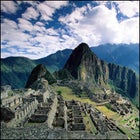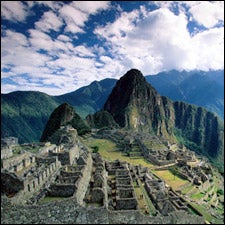Way back in 1999 my girlfriend, brother, and I stepped out from a hired taxi somewhere along a mucky road in Peru and set out to try to find our way to Machu Picchu. We found the trail no problem despite having the absence of a guide and very little in the way of directions. It was January, raining, and though the scenery was spectacularmassive Andean summits and sweeping fog added an air of mystery to the placethe trail was littered with appalling mounds of trash and human crap. Welcome to one of the planet’s unique hiking routes, the Stinka Trail.
Machu Picchu
 City in the Sky: Peru’s Machu Picchu
City in the Sky: Peru’s Machu PicchuThankfully, times have changed. The Peruvian government, as you may know, caught wind of the stench and clamped down hard just a few years later. And after some initial protests, officials have tightened rules even further. Now only professionally qualified guides and licensed tour operators are permitted to take hikers on the ancient route, and no more than 500 trekkers a day are allowed on the trail, including porters, cooks, and guides in your group. Permits to hike the trail and wander around the ruins have shot up
During the high season, that is from April to November when dry, sunny skies yield to cool nights, try to time your hike so that you arrive in Machu Picchu on Tuesday, Thursday, or Sunday. During those days there’s a large market in Pisac, an indigenous town just outside Cuzco, that attracts scores of tourists who might otherwise be at the Lost City. From November to March, expect a lot of rain, but not continual rain. When we were there it was certainly wet but we did have pockets of dry spells when the clouds would part to reveal huge gorges and icy peaks. The trails are much less crowded at this time and closed completely in February for maintenance.
Under no circumstances should you be tempted to book a trip through a taxi driver or street vendor, despite what they may say about official permission. Just assume they’re scamming. Most operators offer two- and four-day versions of the hike. I don’t recommend the two-day hike unless you simply don’t have time. It still takes you to other ruins scattered along the trail, like Huinay Huayna, a sprawling complex of stone rooms and courtyards. But you’ll miss other ruinslike those that served as stopovers for couriers running the trail, for instanceand cuts short the anticipation that grows each day as you get closer and closer to the Sun Gate and the entrance to Machu Picchu. It’s less than nine miles of hiking versus 26 miles on the four-day version.
Several outfitters are worth checking out. InkaNatura Travel (+51.84.25.5255; ) bills itself as the “only leading tour operator in Peru owned by a nonprofit conservation group.” Ethics asidethey reportedly pay and feed their porters wellthey also offer a five-day version of the four-day trek, which sounds kinda cool. That means you get to poke along at the ruins longer and can spend a few extra moments catching your breath up Warmi Wanusca, or Dead Woman’s Pass, the highest point on the trail at just under 14,000 feet; that’s always a good thing. Here in the States, Mountain Travel Sobek (800.687.6235; ) offers Inca Trail trips that also take in the Inti Raymi festival in Cuzco, otherwise known as the Festival of the Sun. Prices are steep, about $3,000 per person for a group up to 15 people, but the company is well-known for service and that price covers a ten-day trip in Peru, starting in Lima. Independent trips arranged on your own through an outfitter in Peru cost about $400. In general, you’ll get what you pay for. With cheaper outfits expect shoddier tents and lower-quality food. Lastly, if you happen to be in Cuzco without a reservation, try walking up to some of the outfitters around the Plaza de Armas to see if they have any last-minute openings. Sometimes they will, but of course they might not. If that’s the case, there’s always the weeklong hike around 20,948-foot Ausangate, a peak the Incas held sacred, to keep you busy until a slot opens up.
Ready to hit the trail? Follow our guide to the inexpensive way to reach South America in the latest guide to .

